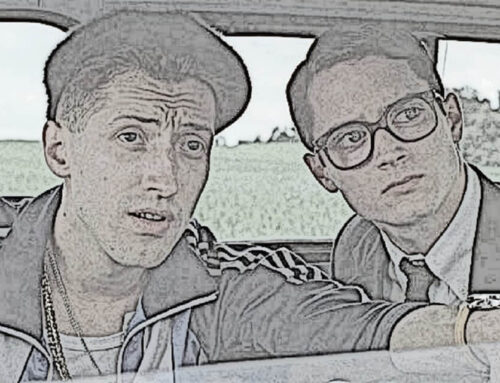Daria Zhukauskaite
Recently, I finished Thinking the Twentieth Century (2012) by Tony Judt and Timothy Snyder. A book that is certainly worth your attention and I urge you to not take my word for it and go see for yourself instead. A reader of FOMOSO will certainly appreciate the great scholars’ takes. This article is based on Chapter 1: The Name Remains: Jewish Questioner and Chapter 4. King’s and Kibbutzim: Cambridge Zionist.
I want to cast your attention on a critical point about understanding Zionism and modern-day Israel, which Tony Judt brings up. It is regarding its roots and the founding movements, which stem from the difference in the lives of the Jewish people across Europe. Judt, who initially was a Zionist, said that there was a face-off between the Central European Bildung-oriented Jews and Eastern European labour Jews. So even in the seemingly far-fetched topic of Israel, Central and Eastern Europe had its influence.
To understand his claim, we must delve into the fundamental divergences between the same people in different parts of Europe.
Eastern European Jews co-existed with the local population on the basis of the interdependence of mutual ignorance because Jewish people lived in ‘hermetically separated social spaces’ – a bubble, in nowadays terms. Due to the career choices limited for Jewish people by law, they did not obtain the skills a Belarussian or a Ukrainian would boast – saddling a horse or ploughing the field was out of their bounds, making them visible outsiders. What further hindered integration in Eastern Europe was the linguistic difference – Yiddish is alien to Slavic speakers. Eastern European Jews stayed in their communities without exposure to local traditions, or religion:
People like my parental grandmother, growing up in her shtetl in Pilviskiai in southwestern Lithuania, knew nothing of the world around them. Like her they knew the shtetl, they knew the imperial capital Vilna, a largely Jewish city – and then the world (to the extent that this meant anything to them). (p.17)
The monopolies given to the Jews in Eastern Europe (e.g., on the distillery, Arendator) ensured further detachment. Isolation was strong and sometimes purposefully forged by the state, especially within the Russian Empire. There was no attachment to the country of residence for Eastern European Jews. Hence, the massive wave of immigration to the states during the 1880s from Eastern Europe[1] – immigration is an easier decision, when there is no attachment to the ‘homeland’, whereas, in post-1933 Central Europe, many Jews still struggled to make the decision to immigrate, George Mosse’s family and his academic exploration of the Bildung-orientated German Jews highlight that.
Central European Jews faced different circumstances. Central European Jews in the mind of an observer are connected to the European high culture – Stefan Zweig, Franz Kafka, Sigmund Freud, to name a few. They were exposed to, what Judt calls, Habsburgian urban oases. Central European Jews were unfamiliar with rural culture but were part of the development of the metropolitan. Moreover, they were fundamental to the cultural scene, they were part and parcel of it. Yiddish is a Germanic language, linguistic similarity brought Central European Jews even closer to their surroundings. Franz Joseph I, unlike other Eastern European rulers, granted Jewish people equal rights. Many Central European Jews grew to identify themselves as Austrians, Hungarians or Germans. We can see Kafka travel between his many identities – Jewish, Czech and German. Adele Bloch-Bauer, Klimt’s inspiration for Judith, in the words of her niece, saw herself as an Austrian and Viennese Jew. Zweig is another example, making his The World of Yesterday (1942 )even more so painful. Nicholas Kaldor, the Hungarian economist, mentions Judt, viewed himself as an urbanite Hungarian Jew, Hungarian identity was equally important to the Jewish one. Central European Jews could integrate and become a crucial part of their societies, which was most of the time impossible in Eastern Europe. Eastern European identity was not on a par with the Jewish one (arguably until the 20th century).
During the Zionism movement, Jewish people all over Europe participated. However, Eastern and Central European mentalities bore little resemblance, resulting in somewhat of a power struggle. Which mentality will define the Zionist movement and the state of Israel? Judt argues that Eastern European labour-orientated mentality prevailed, resulting in the Israeli state we know now. Early Zionism was labour Zionism: young diaspora Jews went to rural Palestine, forming settlements to create a collective Jewish peasantry, ‘neither exploited nor exploiting’ (p. 107). But such Zionism did not tailor to all; for Central European Jews, the Zionist movement was seen as an extension of their cosmopolitan European living. However, European Jews were dominated by the Ashkenazi Jews of Eastern Europe, deeply religious and more oppressed. That is why for them Zionism was an event more dramatic in its nature. Judt argues that the idea of creating an ideal rural community is common not only for Zionism but also for Russian socialism. Another similar feature of the two movements is – the dearth of desire to compromise. Opponents and critics of the movement were seen radically and adopted an uncompromising narrative of the tragic past, as Judt puts it. In this narrative, there is one victor – there is a similarity between this approach and what Hans Kohn defined as Eastern nationalism. Judt writes:
Conversely, the central Europeans could at least imagine a liberal view of History again as the story of progress in which everyone can find a place, and where progress itself assures space and autonomy for all. This unmistakably Viennese way of thinking was from the outset dismissed by clear-headed Russian radicals like Vladimir Jabotinsky as mere flannel. What the Jews were seeking in Palestine, he used to say, was not progress but a state. When you build a state you make a revolution. And in a revolution, there can only ever be winners and losers. This time around we Jews are going to be the winners. (p. 120)
This narrative dominates Israel to this day. The Eastern labour-oriented mentality, which resulted in reactionary revolutionary ideas, dominates modern-day Israel’s governance. Nation-states were a post-WW1 phenomenon for European thought. Israel, which falls under the European thought categorisation, was formed after WW2. As a result, Judt notes, it has adopted paranoid political turmoil and became dependent on the Holocaust, weaponising the historical event for its political goals. Post-WW2 emergence had separate effects: European Jews felt separation all over the continent, and Jewish history relocated from Eastern Europe to Israel. That meant that Israel was distanced from the emerging post-Christian ethics of the European states.
Remembering the roots of the movement and the state is paramount to its understanding, without it no solution to the Israeli-Palestinian conflict can be seen. To analyse modern-day Israel, we must learn more about the lives of the Jewish people in Eastern and Central Europe. Perhaps, the more cosmopolitan and coexistent nature of Central European Jews would have led to a completely different policy regarding the Palestinians.
[1] https://www.myjewishlearning.com/article/jewish-immigration-to-america-three-waves/



